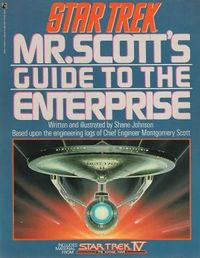Mr. Scott's Guide to the Enterprise
Mr. Scott's Guide to the Enterprise ist ein Nachschlagewerk von Shane Johnson, das vom amerikanischen Verlag Pocket Books vertrieben wurde.
Das Buch ist im Stile des Star Fleet Technical Manuals geschrieben, beschreibt jedoch die USS Enterprise nach ihrem Umbau, sowie den Nachfolger USS Enterprise-A.
Inhaltsverzeichnis
InhaltBearbeiten
- Vom Umschlagtext:
Aided by the logbooks of Chief Engineer Montgomery Scott and recently declassified Starfleet material, Shane Johnson has written the most accurate, in-depth look at the U.S.S. Enterprise available.
For the first time anywhere, deck-by-deck in full, fascinating detail, you will tour the inside of the U.S.S. Enterprise, the United Federation of Planets' most recognized intragalactic ambassador. Using dozens of blueprints, sketches, and photographs, you'll visit the on-ship sites of Captain Kirk, Mister Spock and Commander Scott's most famous adventures—and take a never-before-revealed peek at the inner workings of a starship.
From the engineering room to the captain's quarters, from sickbay to auxiliary control, here is your complete guide to the most famous starship of all—the U.S.S. Enterprise!
EinleitungBearbeiten
Geschrieben von Commander Montgomery Scott, Chefingenieur.
Geschichte des UmbausBearbeiten
Allgemeine InformationenBearbeiten
- Sternenflottenuniformen
- Farbcodes der Uniformen
- Dienstuniform
- Kadett-/Unteroffiziers-Jumpsuit
- Rangabzeichen (Sternenflottenränge)
- Armscherpen
- Schriftsätze
- Schilder
- Türschilder
- Abteilungsschilder
- Schiffswegweiser
Schiffs-LayoutBearbeiten
- A Deck
- Hauptbrücke
- Luftschleuse
- Entwurfsskizzen (von Andrew Probert)
- B-C Decks
- VIP-Einrichtungen
- D-E Decks
- F Deck
- G Deck
- H-I Decks
- J-K Decks
- L-M Decks
- N-O Decks
- P-Q Decks
- R Deck
- S Deck
- T-U Decks
HintergrundinformationenBearbeiten
Laut diesem Buch hieß die USS Enterprise (NCC-1701-A) ursprünglich USS Ti-Ho (NCC-1798). Das Schiff wurde anscheinend zu Ehren eines verstorbenen Freundes des Autoren Shane Johnson benannt. Gene Roddenberry selbst schlug jedoch einmal vor, dass die Enterprise-A die umgebaute USS Yorktown sein könnte. Dieser Hinweis findet sich u.a. im Sachbuch Die Technik der USS Enterprise. Beide Informationen können jedoch nicht kanonisch belegt werden.
